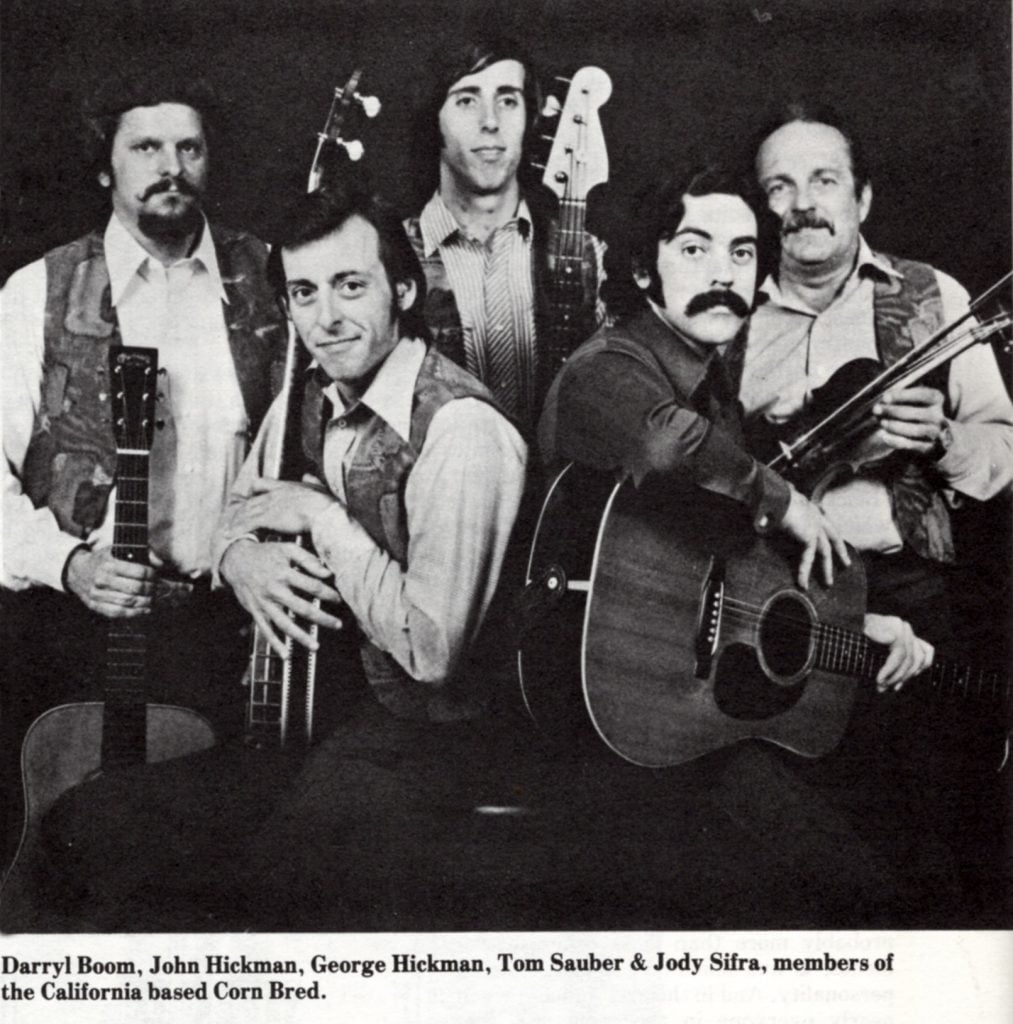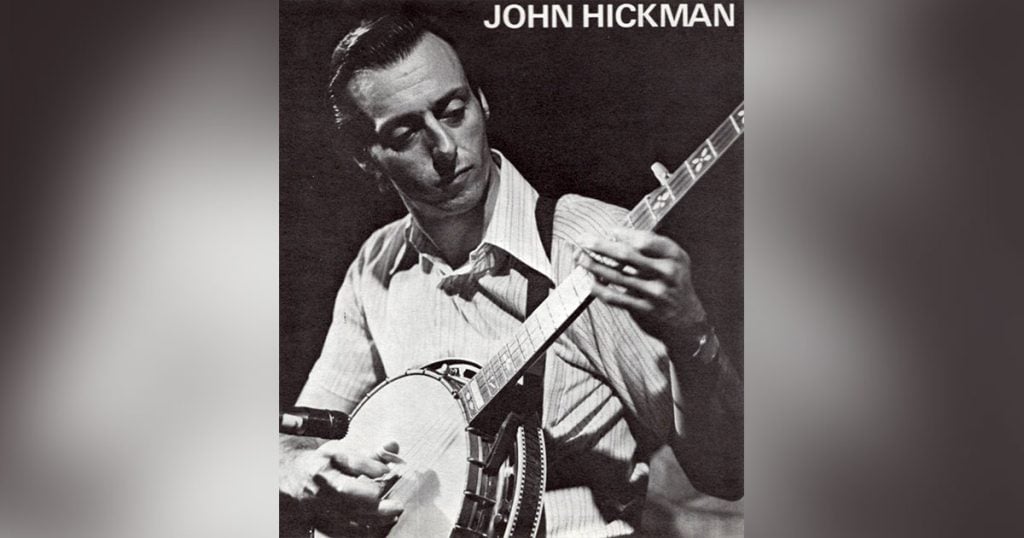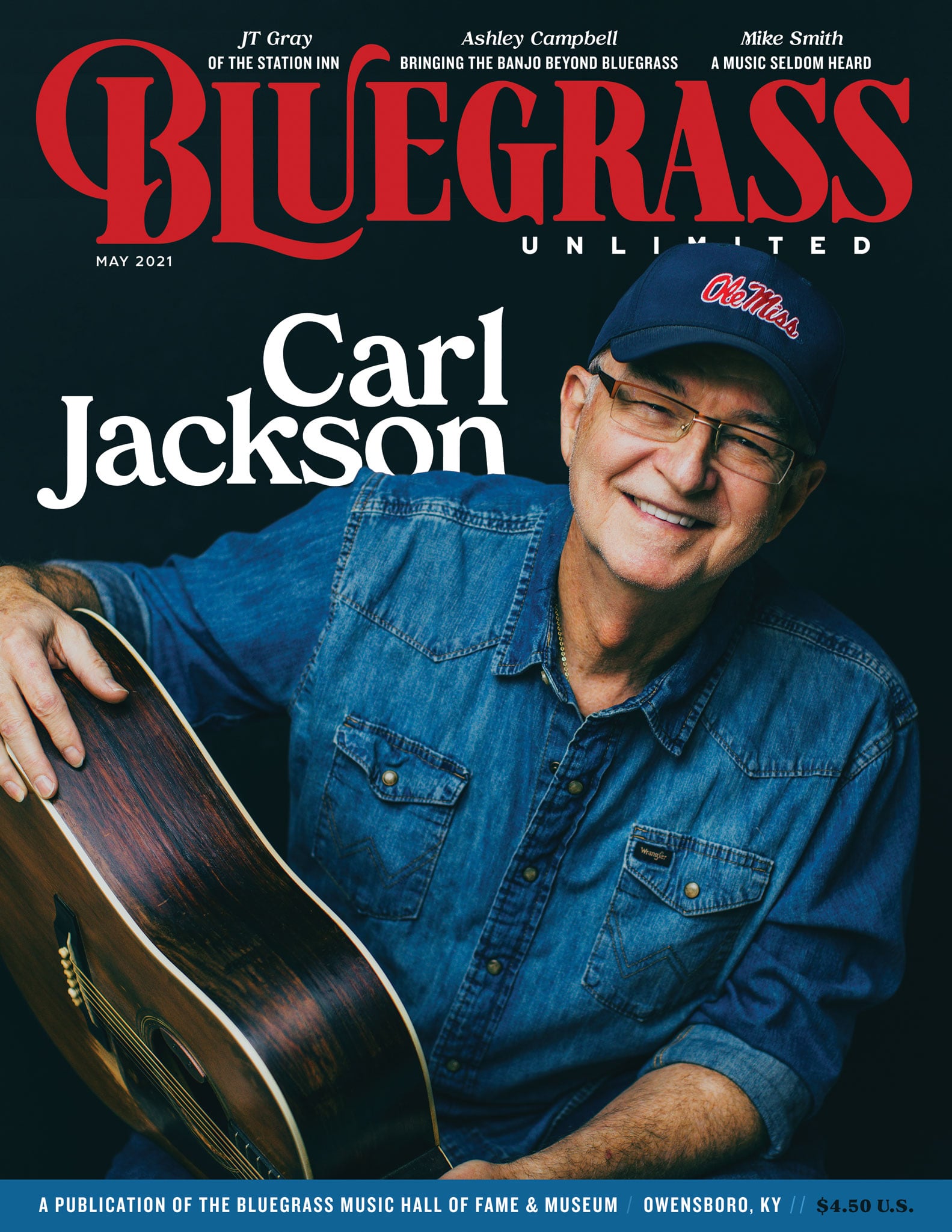Home > Articles > The Archives > John Hickman
John Hickman
Reprinted from Bluegrass Unlimited Magazine
May 1975, Volume 9, Number 11
If you happened to catch the first Smothers Brothers Show as I did, no doubt you remember a certain segment where a quiet, somewhat lanky banjo picker awaited patiently in the shadows until, at last, the proper cue was given, the stage lights turned up, and he let loose with a vibrant rendition of “Dueling Banjos.” As monotonously overplayed as that tune is, the studio audience, of course, ate it up.
Perhaps what you didn’t notice at that time was that the featured banjo player was John Hickman—a name you should well remember.
It was only a few weeks after the show aired that I first met John at his home near the ocean in Torrence, California. Like most other banjo players in the area, I had known about his picking for some time and had often seen him in action with the excellent Los Angeles-based group, Corn Bred. John Hickman has become, to say the least, a household word among many bluegrass musicians on the West Coast.
Hickman was born thirty-two years ago and grew up in Columbus, Ohio. He bought his first banjo in 1957 and after listening intently to all the old Flatt and Scruggs’ 78s, began a life of total dedication to the five-string. He has since become one of the most appreciated and distinctive banjo pickers in California bluegrass circles.
After graduating from high school around 1960, John began first performing professionally in the Columbus area with guitarist Bill Dunken and mandolin player Don Sours. The group was relatively short-lived and in 1962, Hickman enlisted in the Marine Corps. He was fortunate though to have been stationed in West Virginia and during his free time would travel about the countryside with his banjo and occasionally jam with bluegrass musicians such as Buzz Busby, Red Allen, Frank Wakefield and The Kentuckians, Mike Auldridge and Ben Eldridge.
Upon his release from the service in 1964, Hickman headed directly back to Columbus and quickly formed a trio with guitarist Landen Rowe and the late Pee Wee Lambert on mandolin. Though the union lasted for only about a year, John, intent upon continuing his musical career, immediately joined up with the Dixie Gentlemen, another Columbus group comprised of Sid Campbell on guitar, Ralph (Robbie) Robinson on mandolin. Chuck Cordell on bass, and of course, Hickman on the five-string. The group remained strictly local, performing in small clubs and bars around the Columbus area. What was a great loss to all associated with bluegrass, both Robinson and Cordell were killed in a plane crash in West Virginia.
Hickman soon found himself in still a third Columbus group, this time composed of Earl Taylor (of Stoney Mountain Boys fame) and comedian “Boat Whistle” McIntyre. This group stayed together for about three years and like the previous two groups, performed at festivals and small clubs in the vicinity of Columbus.
It was in 1969 that Hickman finally made the move to southern California, and with his wife Sidney, has been living there ever since. Soon after his arrival, John formed a trio with his brother George and mandolinist Scott Hambly. The group quickly worked up enough material to perform in a “Bluegrass Showcase” at McCabes—a Santa Monica music store-turned concert hall and a leading force in the promotion of traditional folk and bluegrass music on the West Coast.
It was there at McCabes, John told me, that he was “discovered” by fiddler Byron Berline and banjoist Alan Munde, both of the Country Gazette. Berline and Munde frequented McCabes, especially when the show featured bluegrass, and it was fortunate for John’s career that they did. Berline, it seems, was extremely impressed with Hickman’s command of the five-string, and through him, John was introduced and became close picking friends with such musicians as the late Clarence White and his brother Roland, Doug Dillard, and John Hartford.
Since settling in the Los Angeles area, Hickman stacked up a number of important credits previous to his job on the Smothers’ Show: he has played on a country album featuring Danny Michaels; dubbed banjo over a number of rock tunes; sat in on what he described was a country-gospel album which also included Byron Berline, Roland White, Roger Bush (of the Country Gazette), and Dobro player Leroy Mack (once associated with The Kentucky Colonels). Hickman’s banjo playing can also be heard on the album “Black Mountain Blues” on Briar Records, which features fiddler Leslie Keith, composer of the famous “Black Mountain Rag.” John has done a seventeen-day western promotional tour for Disneyland and with Corn Bred, recorded a radio commercial for Retronox (an anti-smog device).

Though Hickman enjoys performing on stage with a group, he states that the most favorable environment for him as a musician is that of the recording studio. According to John, a studio situation offers the bluegrass instrumentalist an exceptional amount of musical freedom, and by its very nature, inspires innovation. Hickman feels that the banjo, probably more than most other instruments, is and should be a projection of personality. And in this day and age when nearly everyone in the industry, from rock producers to television commercial directors, are attempting to take advantage of the ever-rising popularity of bluegrass, the banjo player, Hickman feels, is presented a new and exciting challenge for expressing his creativity as a musician.
“I like the relaxed atmosphere of the studio,” says John. In a typical recording session, he explains, the banjo player usually works only from a simple chord chart and is generally allowed the freedom to play what he personally feels would fit best into any particular tune. Occasionally though, Hickman commented, a producer would have something special in mind that he would like the banjoist to insert at a certain segment of the song. In the majority of cases however, John stated, the musician is allowed to pretty much follow his own instincts.
Rather that working out entire arrangements to songs, Hickman feels it best to concentrate upon learning a variety of “tasteful” licks. This, he explained, can be tremendously helpful in a studio situation, especially when the tune requiring a banjo overdub is not of a traditionally bluegrass nature. The five-string banjo, Hickman feels, is basically compatible to almost any kind of music, and he is quick to cite Bobby Thompson as a perfect example.
John is not signed with any particular recording label but can be considered a “freelance” banjo player. Usually, he explained, a studio job is transmitted by word of mouth and whatever bluegrass musician in the area is available at the time, gets the job. John commented that fiddler Byron Berline plays an important role in rounding up studio gigs for bluegrass musicians around the Los Angeles area. Because Berline is so well known as a sutdio instrumentalist himself, record producers would, in many cases, ask him if he knows of any banjo player that could do a session. For example, Hickman told me, it was actually through Berline that he got the job on the Smothers’ Show.
More recently, John and the group he is presently associated with, Corn Bred, has cut a soon-to-be-released album of bluegrass entitled, “It’s Hot” on the Briar-Takoma label. This fine and respected L.A.-based group, together with Hickman, is comprised of Darryl Boom-guitar, George Hickman-bass, Tom Sauber-mandolin, and Jody Sifra-fiddle. As an added note, Hickman informed me that the group will possibly be performing with Zubin Meta and the Los Angeles Symphony later this year.
John Hickman’s banjo playing, like so many pickers today, is a “conglomeration” of a number of different styles ranging from Scruggs to Adcock. What sets him apart from most, however, is that John projects a uniqueness and freshness that can be attributable only to his personal inventiveness as a musician. When I asked John what he felt the major influences upon his style to be, he was quick to mention many: The “flashiness” of Reno; the back-up techniques of Eddie Adcock; the “hard-driving” right hand of Bill Emerson; and of course, the “bluesy” chromatics of Bobby Thompson.
After listening to Hickman’s picking for only a few minutes, it is easy for one to recognize all those influences at work, and much more. Playing on a 1926 style-6 Mastertone flat head set up with medium gauge strings, and exhibiting little more expression on his face than an occasional blink, John delivers a full and driving sound comparable to that of Reno, but with the complicated subtleties of a Keith or a Thompson.
It is evident in Hickman’s playing that to him tradition is as important as innovation; consistency and freshness as essential as outright flashiness. John probably describes his own style best by simply stating,“I just play what I like to hear.”
Besides performing with Corn Bred, John works as a banjo instructor and instrument repairman at Lively Arts Music Store in Torrence. He is often asked to judge many of the California banjo and fiddle contests as well as performing in them. From recording studio and television tapings to delighting audiences at the local clubs, John Hickman has become one of the most appreciated musicians among both bluegrass amateurs and professionals alike.
Content to stay at home (though he has been offered opportunities to travel with both Jimmy Martin and Bill Monroe), John’s main concern as a musician is, as he puts it, “the promotion of bluegrass music,” and his love for it is evident’, not only in his playing, but in nearly every facet of his life.

